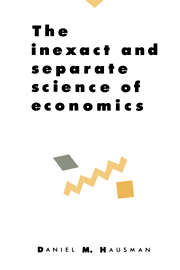Book contents
- Frontmatter
- Contents
- List of figures
- Dedication
- Introduction
- Part I Introduction, structure, and strategy
- Part II Theory assessment
- 8 Inexactness in economic theory
- 9 Methodological revolution
- 10 Karl Popper and falsificationism in economics
- 11 Imre Lakatos and economic methodology
- 12 Economics as an inexact and separate science
- 13 On dogmatism in economics: the case of preference reversals
- Part III Conclusion
- Appendix: An introduction to philosophy of science
- Bibliography
- Index
8 - Inexactness in economic theory
Published online by Cambridge University Press: 04 August 2010
- Frontmatter
- Contents
- List of figures
- Dedication
- Introduction
- Part I Introduction, structure, and strategy
- Part II Theory assessment
- 8 Inexactness in economic theory
- 9 Methodological revolution
- 10 Karl Popper and falsificationism in economics
- 11 Imre Lakatos and economic methodology
- 12 Economics as an inexact and separate science
- 13 On dogmatism in economics: the case of preference reversals
- Part III Conclusion
- Appendix: An introduction to philosophy of science
- Bibliography
- Index
Summary
The standard view of theory appraisal is the so-called “hypothetico-deductive” or “HD” method, which is presented in the introductory chapters of countless economic textbooks (see A.10.1). Stripped to its bare bones, the HD method consists of four steps:
Formulate a hypothesis.
Deduce a prediction from the hypothesis and other statements.
Test the prediction.
Evaluate the hypothesis on the basis of the test results.
The inexactness of the basic “laws” of equilibrium theory and the many consequent failures of particular applications makes the fourth step difficult. Given how many interferences there may be, economists have little basis for increased confidence in an hypothesis when things are as predicted, and they have little basis for lessened confidence when things are not as predicted. How can economists learn from experience? Similar difficulties arise when one thinks of assessment in terms of Bayesian (A.10.2) or bootstrapping (A.10.3) approaches, but for now let us stick with the familiar HD method.
One solution is offered by the view of theory appraisal in economics that dominated methodological discussion until the 1940s and that still appears to dominate methodological practice. This view dates back at least to David Ricardo's time. It was first explicitly enunciated in the 1830s and 1840s by John Stuart Mill (1836, 1843) and Nassau Senior (1836). I shall focus on Mill's more sophisticated discussions.
- Type
- Chapter
- Information
- The Inexact and Separate Science of Economics , pp. 123 - 151Publisher: Cambridge University PressPrint publication year: 1992
- 1
- Cited by



